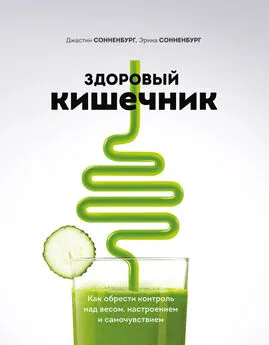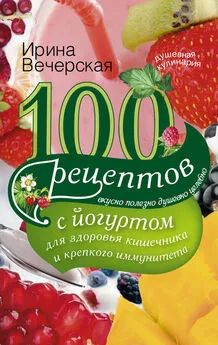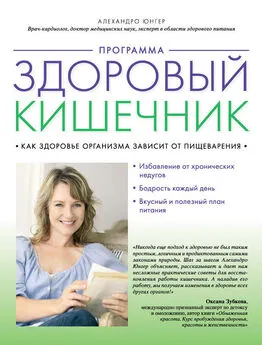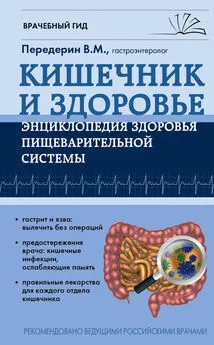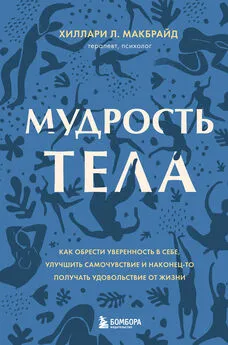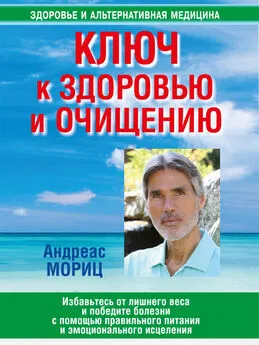Джастин Сонненбург - Здоровый кишечник. Как обрести контроль над весом, настроением и самочувствием
- Название:Здоровый кишечник. Как обрести контроль над весом, настроением и самочувствием
- Автор:
- Жанр:
- Издательство:Манн, Иванов и Фербер
- Год:2018
- Город:Москва
- ISBN:978-5-00117-564-3
- Рейтинг:
- Избранное:Добавить в избранное
-
Отзывы:
-
Ваша оценка:
Джастин Сонненбург - Здоровый кишечник. Как обрести контроль над весом, настроением и самочувствием краткое содержание
Здоровый кишечник. Как обрести контроль над весом, настроением и самочувствием - читать онлайн бесплатно ознакомительный отрывок
Интервал:
Закладка:
Johansson, M. E., et al. “Bacteria Penetrate the Normally Impenetrable Inner Colon Mucus Layer in Both Murine Colitis Models and Patients with Ulcerative Colitis”. Gut 63.2 (2014): 281–291. Print.
Johnston, G. W., and H. W. Rodgers. “Treatment of Chronic Portal-Systemic Encephalopathy by Colectomy”. Br J Surg 52 (1965): 424–426. Print.
Kashyap, P. C., et al. “Complex Interactions among Diet, Gastrointestinal Transit, and Gut Microbiota in Humanized Mice”. Gastroenterology 144.5 (2013): 967–977. Print.
Kendall, A. I. “The Bacteria of the Intestinal Tract of Man”. Science 42.1076 (1915): 209–212. Print.
Koenig, J. E., et al. “Succession of Microbial Consortia in the Developing Infant Gut Microbiome”. Proc Natl Acad Sci U S A 108 Suppl 1 (2011): 4578–4585. Print.
Koeth, R. A., et al. “Intestinal Microbiota Metabolism of L–Carnitine, a Nutrient in Red Meat, Promotes Atherosclerosis”. Nat Med 19.5 (2013): 576–585. Print.
Koren, O., et al. “Host Remodeling of the Gut Microbiome and Metabolic Changes During Pregnancy”. Cell 150.3 (2012): 470–480. Print.
Kozyrskyj, A. L., P. Ernst, and A. B. Becker. “Increased Risk of Childhood Asthma from Antibiotic Use in Early Life”. Chest 131.6 (2007): 1753–1759. Print.
Kuoliok, K. E. Food and Emergency Food in the Circumpolar Area . Almquist och Wiksell, 1969. Print.
Le Chatelier, E., et al. “Richness of Human Gut Microbiome Correlates with Metabolic Markers”. Nature 500.7464 (2013): 541–546. Print.
Lee, S. M., et al. “Bacterial Colonization Factors Control Specificity and Stability of the Gut Microbiota”. Nature 501.7467 (2013): 426–429. Print.
Lee, Y. K., et al. “Proinflammatory T-Cell Responses to Gut Microbiota Promote Experimental Autoimmune Encephalomyelitis”. Proc Natl Acad Sci U S A 108 Suppl 1 (2011): 4615–4522. Print.
Lewis, S. J., and K. W. Heaton. “Stool Form Scale as a Useful Guide to Intestinal Transit Time”. Scand J Gastroenterol 32.9 (1997): 920–924. Print.
Ley, R. E., et al. “Obesity Alters Gut Microbial Ecology”. Proc Natl Acad Sci U S A 102.31 (2005): 11070–11075. Print.
Lin, A., et al. “Distinct Distal Gut Microbiome Diversity and Composition in Healthy Children from Bangladesh and the United States”. PLoS One 8.1 (2013): e53838. Print.
Lin, P. W., and B. J. Stoll. “Necrotising Enterocolitis”. Lancet 368.9543 (2006): 1271–1283. Print.
Lyte, M., et al. “Induction of Anxiety-Like Behavior in Mice During the Initial Stages of Infection with the Agent of Murine Colonic Hyperplasia Citrobacter Rodentium”. Physiol Behav 89.3 (2006): 350–357. Print.
Machiels, K., et al. “A Decrease of the Butyrate-Producing Species Roseburia Hominis and Faecalibacterium Prausnitzii Defines Dysbiosis in Patients with Ulcerative Colitis”. Gut 63.8 (2014): 1275–1283. Print.
Marcobal, A., “Bacteroides in the Infant Gut Consume Milk Oligosaccharides via Mucus-Utilization Pathways”. Cell Host Microbe 10.5 (2011): 507–514. Print.
Martens, E. C., et al. “The Devil Lies in the Details: How Variations in Polysaccharide Fine-Structure Impact the Physiology and Evolution of Gut Microbes”. J Mol Biol (2014). Print.
McDonald, L. C., et al. “Vital Signs: Preventing Clostridium difficile Infections”. MMWR Morb Mortal Wkly Rep 61.9 (2012): 1157–1167. Print.
McGovern, P. E., et al. “Fermented Beverages of Pre- and Proto-Historic China”. Proc Natl Acad Sci U S A 101.51 (2004): 17593–17598. Print.
Merenstein, D., et al. “Use of a Fermented Dairy Probiotic Drink Containing Lactobacillus Casei (DN-114 001) to Decrease the Rate of Illness in Kids: The Drink Study. A Patient-Oriented, Double-Blind, Cluster-Randomized, Placebo-Controlled, Clinical Trial”. Eur J Clin Nutr 64.7 (2010): 669–677. Print.
Messaoudi, M., et al. “Assessment of Psychotropic-Like Properties of a Probiotic Formulation (Lactobacillus Helveticus R0052 and Bifidobacterium Longum R0175) in Rats and Human Subjects”. Br J Nutr 105.5 (2011): 755–764. Print.
Mueller, S., et al. “Differences in Fecal Microbiota in Different European Study Populations in Relation to Age, Gender, and Country: A Cross-Sectional Study”. Appl Environ Microbiol 72.2 (2006): 1027–1033. Print.
Neufeld, K. M., et al. “Reduced Anxiety-Like Behavior and Central Neurochemical Change in Germ-Free Mice”. Neurogastroenterol Motil 23.3 (2011): 255–264, e119. Print.
Ng, K. M., et al. “Microbiota-Liberated Host Sugars Facilitate Post-Antibiotic Expansion of Enteric Pathogens”. Nature 502.7469 (2013): 96–99. Print.
Nieuwdorp, M., A. Vrieze, and W. M. de Vos. “Reply to Konstantinov and Peppelenbosch”. Gastroenterology 144.4 (2013): e20–е21. Print.
Olszak, T., et al. “Microbial Exposure During Early Life Has Persistent Effects on Natural Killer T Cell Function”. Science 336.6080 (2012): 489–493. Print.
O’Mahony, L., et al. “Lactobacillus and Bifidobacterium in Irritable Bowel Syndrome: Symptom Responses and Relationship to Cytokine Profiles”. Gastroenterology 128.3 (2005): 541–551. Print.
O’Mahony, S. M., et al. “Early Life Stress Alters Behavior, Immunity, and Microbiota in Rats: Implications for Irritable Bowel Syndrome and Psychiatric Illnesses”. Biol Psychiatry 65 (2009): 263–267. Print.
O’Mahony, S. M., et al. “Maternal Separation as a Model of Brain-Gut Axis Dysfunction”. Psychopharmacology (Berl) 2 14.1 (2011): 71–88. Print.
Palmer, C., et al. “Development of the Human Infant Intestinal Microbiota”. PLoS Biol 5.7 (2007): e177. Print.
Petersson, J., et al. “Importance and Regulation of the Colonic Mucus Barrier in a Mouse Model of Colitis”. Am J Physiol Gastrointest Liver Physiol 300.2 (2011): G327–G333. Print.
Petrof, E. O., et al. “Stool Substitute Transplant Therapy for the Eradication of Clostridium Difficile Infection: ‘Repoopulating’ the Gut”. Microbiome 1.1 (2013): 3. Print.
Rabbani, G. H., et al. “Green Banana Reduces Clinical Severity of Childhood Shigellosis: A Double-Blind, Randomized, Controlled Clinical Trial”. Pediatr Infect Dis J 28.5 (2009): 420–425. Print.
Raninen, K., et al. “Dietary Fiber Type Reflects Physiological Functionality: Comparison of Grain Fiber, Inulin, and Polydextrose”. Nutr Rev 6 9.1 (2011): 9–21. Print.
Rao, A. V., et al. “A Randomized, Double-Blind, Placebo-Controlled Pilot Study of a Probiotic in Emotional Symptoms of Chronic Fatigue Syndrome”. Gut Pathog 1.1 (2009): 6. Print.
Reid, R. M. “Cultural and Medical Perspectives on Geophagia”. Med Anthropol 13.4 (1992): 337–351. Print.
Ridaura, V. K., et al. “Gut Microbiota from Twins Discordant for Obesity Modulate Metabolism in Mice”. Science 341.6150 (2013): 1241214. Print.
Riordan, S. M., and R. Williams. “Gut Flora and Hepatic Encephalopathy in Patients with Cirrhosis”. N Engl J Med 362.12 (2010): 1140–1142. Print.
Robertson, K. L., et al. “Adaptation of the Black Yeast Wangiella Dermatitidis to Ionizing Radiation: Molecular and Cellular Mechanisms”. PLoS One 7.11 (2012): e48674. Print.
Russell, W. R., et al. “High-Protein, Reduced-Carbohydrate Weight-Loss Diets Promote Metabolite Profiles Likely to Be Detrimental to Colonic Health”. Am J Clin Nutr 93.5 (2011): 1062–1072. Print.
Russell, W. R., et al. “Colonic Bacterial Metabolites and Human Health”. Curr Opin Microbiol 16.3 (2013): 246–254. Print.
Salyers, A. A., et al. “Fermentation of Mucin and Plant Polysaccharides by Strains of Bacteroides from the Human Colon”. Appl Environ Microbiol 33.2 (1977): 319–322. Print.
Sanders, M. E., and J. T. Heimbach. “Functional Foods in the USA: Emphasis on Probiotic Foods”. Food Sci Technol Bull 1.8 (2004): 1–10. Print.
Savage, J. H., et al. “Urinary Levels of Triclosan and Parabens Are Associated with Aeroallergen and Food Sensitization”. J Allergy Clin Immunol 130.2 (2012): 453–460. e7. Print.
Schnorr, S. L., et al. “Gut Microbiome of the Hadza Hunter-Gatherers”. Nat Commun 5 (2014): 3654. Print.
Smith, M. B., C. Kelly, and E. J. Alm. “Policy: How to Regulate Faecal Transplants”. Nature 506.7488 (2014): 290–291. Print.
Smith, P. M., et al. “The Microbial Metabolites, Short-Chain Fatty Acids, Regulate Colonic Treg Homeostasis”. Science 341.6145 (2013): 569–573. Print.
Sokol, H., et al. “Faecalibacterium Prausnitzii Is an Anti-Inflammatory Commensal Bacterium Identified by Gut Microbiota Analysis of Crohn Disease Patients”. Proc Natl Acad Sci U S A 105.43 (2008): 16731–16736. Print.
Song, S. J., et al. “Cohabiting Family Members Share Microbiota with One Another and with Their Dogs”. Elife 2 (2013): e00458. Print.
Sonnenburg, E. D., and J. L. Sonnenburg. “Starving Our Microbial Self: The Deleterious Consequences of a Diet Deficient in Microbiota-Accessible Carbohydrates”. Cell Metab (2014). Print.
Sonnenburg, J. L., et al. “Glycan Foraging in Vivo by an Intestine-Adapted Bacterial Symbiont”. Science 307.5717 (2005): 1955–1959. Print.
Strachan, D. P. “Hay Fever, Hygiene, and Household Size”. Bmj 299.6710 (1989): 1259–1260. Print.
Sudo, N., et al. “Postnatal Microbial Colonization Programs the Hypothalamic-Pituitary-Adrenal System for Stress Response in Mice”. J Physiol 558.Pt 1 (2004): 263–275. Print.
Tarnow-Mordi, W., and R. F. Soll. “Probiotic Supplementation in Preterm Infants: It Is Time to Change Practice”. J Pediatr 164.5 (2014): 959–960. Print.
Thompson, J. D. “The Great Stench or the Fool’s Argument”. Yale J Biol Med 64.5 (1991): 529–541. Print.
Tillisch, K., et al. “Consumption of Fermented Milk Product with Probiotic Modulates Brain Activity”. Gastroenterology 144.7 (2013): 1394–1401, 401.e1–e4. Print.
Torrey, J. C. “The Regulation of the Intestinal Flora of Dogs through Diet”. J Med Res 39.3 (1919): 415–447. Print.
Trasande, L., et al. “Infant Antibiotic Exposures and Early-Life Body Mass”. Int J Obes (Lond) 37.1 (2013): 16–23. Print.
Trowell, H. C., and D. P. Burkitt. “The Development of the Concept of Dietary Fibre”. Mol Aspects Med 9.1 (1987): 7–15. Print.
Turnbaugh, P. J., et al. “An Obesity-Associated Gut Microbiome with Increased Capacity for Energy Harvest”. Nature 444.7122 (2006): 1027–1031. Print.
van Nood, E., et al. “Duodenal Infusion of Donor Feces for Recurrent Clostridium Difficile”. N Engl J Med 368.5 (2013): 407–415. Print.
van Nood, E., et al. “Fecal Microbiota Transplantation: Facts and Controversies”. Curr Opin Gastroenterol 30.1 (2014): 34–39. Print.
Viaud, S., et al. “The Intestinal Microbiota Modulates the Anticancer Immune Effects of Cyclophosphamide”. Science 342.6161 (2013): 971–976. Print.
Vrieze, A., et al. “Transfer of Intestinal Microbiota from Lean Donors Increases Insulin Sensitivity in Individuals with Metabolic Syndrome”. Gastroenterology 143.4 (2012): 913–916. e7. Print.
Wang, Y., et al. “16S rRNA Gene-Based Analysis of Fecal Microbiota from Preterm Infants with and without Necrotizing Enterocolitis”. ISME J 3.8 (2009): 944–954. Print.
Читать дальшеИнтервал:
Закладка:
